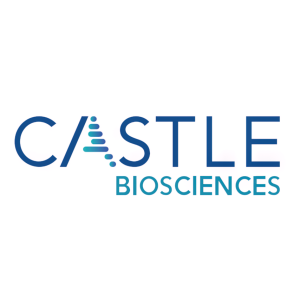New Analysis of 13,560 Patients Demonstrates DecisionDx®-Melanoma Stratifies Risk Across Histological Subtypes; Findings to be Presented at Fall Clinical Dermatology Conference
Rhea-AI Summary
Castle Biosciences (Nasdaq: CSTL) announced presentation of validation data showing its DecisionDx-Melanoma test stratified risk across histological subtypes in a real-world cohort of 13,560 stage I–III cutaneous melanoma patients.
Key findings include five-year melanoma-specific survival differences by test class (example: nodular melanoma 98.5% vs 82.3% for Class 1A vs 2B) and higher early distant-metastasis rates in Class 2B (AJCC stage I–II cohort n=1,661; CNS 7.4% vs 0.9%).
Castle also presented prospective, multicenter data (49 U.S. sites) for a 487-gene atopic dermatitis GEP that identifies a JAKi responder profile to guide systemic therapy selection.
Positive
- Real-world cohort of 13,560 stage I–III patients demonstrating stratification
- Nodular melanoma five-year MSS: 98.5% vs 82.3% (Class 1A vs 2B)
- AJCC stage I–II subgroup (n=1,661) shows CNS DM 7.4% vs 0.9% (Class 2B vs 1A)
- Pipeline AD test from a prospective, multicenter study across 49 U.S. sites
- 487-gene AD GEP identifies a JAKi responder profile linked to rapid, deep responses
Negative
- None.
News Market Reaction 1 Alert
On the day this news was published, CSTL gained 1.36%, reflecting a mild positive market reaction.
Data tracked by StockTitan Argus on the day of publication.
This new histological subtype data confirms DecisionDx-Melanoma’s clinical value across the spectrum of melanoma
Castle Biosciences will also present validation data on its atopic dermatitis pipeline test
FRIENDSWOOD, Texas, Oct. 24, 2025 (GLOBE NEWSWIRE) -- Castle Biosciences, Inc. (Nasdaq: CSTL), a company improving health through innovative tests that guide patient care, today announced that it is presenting data on its DecisionDx®-Melanoma test and its pipeline atopic dermatitis (AD) gene expression profile (GEP) test at the 25th Annual Fall Clinical Dermatology Conference®, taking place Oct. 23–26, 2025, in Las Vegas, Nevada.
“The DecisionDx-Melanoma test has demonstrated clinically significant risk stratification of melanoma. This current study with 13,560 patients is unique in that the clinically relevant risk stratification was seen and reported across histological subtypes of melanoma,” said Etan Marks, D.O., board-certified pathologist, hematopathologist and dermatopathologist at Advanced Dermatology in Delray Beach, Florida. “This study is particularly important as it demonstrates that DecisionDx-Melanoma provides consistent risk stratification across varying types of melanoma and reinforces its value in providing important prognostic information to inform risk aligned management plans, even for patients with different subtypes of melanoma.”
Details regarding Castle’s posters are included below:
DecisionDx-Melanoma
Title: The 31-gene expression profile test stratifies melanoma-specific survival across histological subtypes in patients with cutaneous melanoma
- Lead Author: Etan Marks, D.O.
- Summary: Cutaneous melanoma (CM) subtypes, such as superficial spreading and nodular melanoma, vary in how often they occur and in their outcomes. Even among patients with the same subtype, differences in tumor biology can lead to very different prognoses. In a real-world cohort of 13,560 patients with stage I–III CM from Castle's ongoing collaboration with the National Cancer Institute's Surveillance, Epidemiology and End Results (NCI's SEER) Program Registries, DecisionDx-Melanoma stratified melanoma-specific survival (MSS) across different tumor subtypes. For example, five-year MSS in nodular melanoma was
98.5% for patients with Class 1A (lowest risk) test results versus82.3% for patients with Class 2B (highest risk) test results; similar stratification was observed across superficial spreading, lentigo maligna and unspecified subtypes. These results suggest that the test provides clarity in overall risk beyond histology, supporting more informed treatment planning and potentially improved outcomes.
Title: The 31-gene expression profile identifies patients at risk of developing early distant metastases and can guide risk-appropriate surveillance strategies
- Lead Author: Merve Hasanov, M.D., The Ohio State University Comprehensive Cancer Center, Columbus, Ohio
- Summary: This study demonstrates that DecisionDx-Melanoma can identify early-stage CM patients (American Joint Committee on Cancer (AJCC) stage I-II, n=1,661) at higher risk of distant metastasis (DM) not only to the central nervous system (CNS), but also to the lung, liver and bone. Patients with Class 2B (highest risk) results had significantly higher DM rates compared to Class 1A (lowest risk) patients across all sites (e.g., CNS
7.4% vs.0.9% ; lung7.4% vs.1.2% ; p<0.001). Class 2B patients also had significantly lower five-year DM-free survival, with elevated risk persisting several years after diagnosis. These findings support combining DecisionDx-Melanoma with AJCC staging to identify high-risk patients for tailored surveillance and earlier detection strategies.
Pipeline AD GEP test
Title: The 487-gene expression profile test guides systemic therapy selection to improve outcomes for patients with atopic dermatitis: Results from a prospective, multi-center trial.
- Lead Author: Jonathan I. Silverberg, M.D., Ph.D., MPH, George Washington University School of Medicine and Health Sciences, Washington, D.C.
- Summary: Systemic therapy selection in AD is often trial-and-error, leaving up to half of patients inadequately controlled on biologics targeting the Th2 pathway or on Janus kinase (JAK) inhibitors (JAKi). For many patients, first-line therapy does not achieve adequate disease control, causing delayed improvement, patient dissatisfaction and increased healthcare usage. Data from Castle’s prospective development and validation study show that Castle’s pipeline AD test can classify the patient’s underlying disease biology as having a Th2 Molecular Profile or a JAKi Responder Profile to help guide treatment decision-making. These results demonstrate that Castle’s pipeline test can identify a group of patients with AD who are significantly more likely to experience rapid and deep responses to JAK inhibitors. Understanding the underlying biology that is driving an individual patient’s symptoms may help shift AD care from trial-and-error prescribing to more personalized treatment, potentially improving treatment success and patient satisfaction, and lowering healthcare costs.
“We are pleased to see the results of our prospective, multicenter development and validation study demonstrate clinically meaningful and statistically significant differences between patients who have a JAKi responder profile who are treated with a JAKi compared to those treated with a Th2-targeted therapy,” said Matthew Goldberg, M.D., senior vice president, medical, at Castle Biosciences.
Derek Maetzold, president and chief executive officer of Castle Biosciences, stated, “We would like to thank the 49 U.S. clinical sites who worked with us to achieve this dataset and look forward to seeing the impact that our test may have on improving the outcomes of patients with moderate-to-severe AD.”
About DecisionDx-Melanoma
DecisionDx-Melanoma is a 31-gene expression profile (31-GEP) risk stratification test. It is designed to inform two clinical questions in the management of cutaneous melanoma: a patient’s individual risk of sentinel lymph node (SLN) positivity and a patient's personal risk of melanoma recurrence and/or metastasis. By integrating tumor biology with clinical and pathologic factors using a validated proprietary algorithm, DecisionDx-Melanoma is designed to provide a comprehensive and clinically actionable result to guide risk-aligned patient care. DecisionDx-Melanoma has been shown to be associated with improved patient survival and has been studied in more than 10,000 patient samples. DecisionDx-Melanoma’s clinical value is supported by more than 50 peer-reviewed and published studies, providing confidence in disease management plans that incorporate the test’s results. Through June 30, 2025, DecisionDx-Melanoma has been ordered more than 210,000 times for patients diagnosed with cutaneous melanoma. Learn more at www.CastleBiosciences.com.
About Castle Biosciences
Castle Biosciences (Nasdaq: CSTL) is a leading diagnostics company improving health through innovative tests that guide patient care. The Company aims to transform disease management by keeping people first: patients, clinicians, employees and investors.
Castle’s current portfolio consists of tests for skin cancers, Barrett’s esophagus and uveal melanoma. Additionally, the Company has active research and development programs for tests in these and other diseases with high clinical need, including its test in development to help guide treatment decisions for patients with moderate-to-severe atopic dermatitis. To learn more, please visit www.CastleBiosciences.com and connect with us on LinkedIn, Facebook, X and Instagram.
DecisionDx-Melanoma, DecisionDx-CMSeq, i31-SLNB, i31-ROR, DecisionDx-SCC, MyPath Melanoma, TissueCypher, DecisionDx-UM, DecisionDx-PRAME and DecisionDx-UMSeq are trademarks of Castle Biosciences, Inc.
Forward-Looking Statements
This press release contains forward-looking statements within the meaning of Section 27A of the Securities Act of 1933, as amended, and Section 21E of the Securities Exchange Act of 1934, as amended, which are subject to the “safe harbor” created by those sections. These forward-looking statements include, but are not limited to, statements concerning: DecisionDx-Melanoma’s ability to provide (i) comprehensive, personalized results to guide risk-aligned management decisions for patients diagnosed with stage I-III cutaneous melanoma, and (ii) precise and clinically meaningful risk stratification; DecisionDx-Melanoma’s performance versus other tests currently on the market; the ability of Castle's pipeline AD test to (i) classify a patient's underlying disease biology to help guide systemic therapy selection, and (ii) identify patients with AD who are significantly more likely to experience rapid and deep responses to JAK inhibitors; and the potential to shift AD care from trial-and-error prescribing to personalized treatment. The words “believe,” “can,” “may” and similar expressions are intended to identify forward-looking statements, although not all forward-looking statements contain these identifying words. We may not actually achieve the plans, intentions or expectations disclosed in our forward-looking statements, and you should not place undue reliance on our forward-looking statements. Actual results or events could differ materially from the plans, intentions and expectations disclosed in the forward-looking statements that we make. These forward-looking statements involve risks and uncertainties that could cause our actual results to differ materially from those in the forward-looking statements, including, without limitation: subsequent study or trial results and findings may contradict earlier study or trial results and findings or may not support the results obtained in these studies, including with respect to the discussion of our tests in this press release; actual application of our tests may not provide the aforementioned benefits to patients; and the risks set forth under the heading “Risk Factors” in our Annual Report on Form 10-K for the year ended December 31, 2024, and our Quarterly Report on Form 10-Q for the quarter ended June 30, 2025, each as filed with the SEC, and in our other filings with the SEC. The forward-looking statements are applicable only as of the date on which they are made, and we do not assume any obligation to update any forward-looking statements, except as may be required by law.
Investor Contact:
Camilla Zuckero
czuckero@castlebiosciences.com
Media Contact:
Allison Marshall
amarshall@castlebiosciences.com
Source: Castle Biosciences, Inc.








